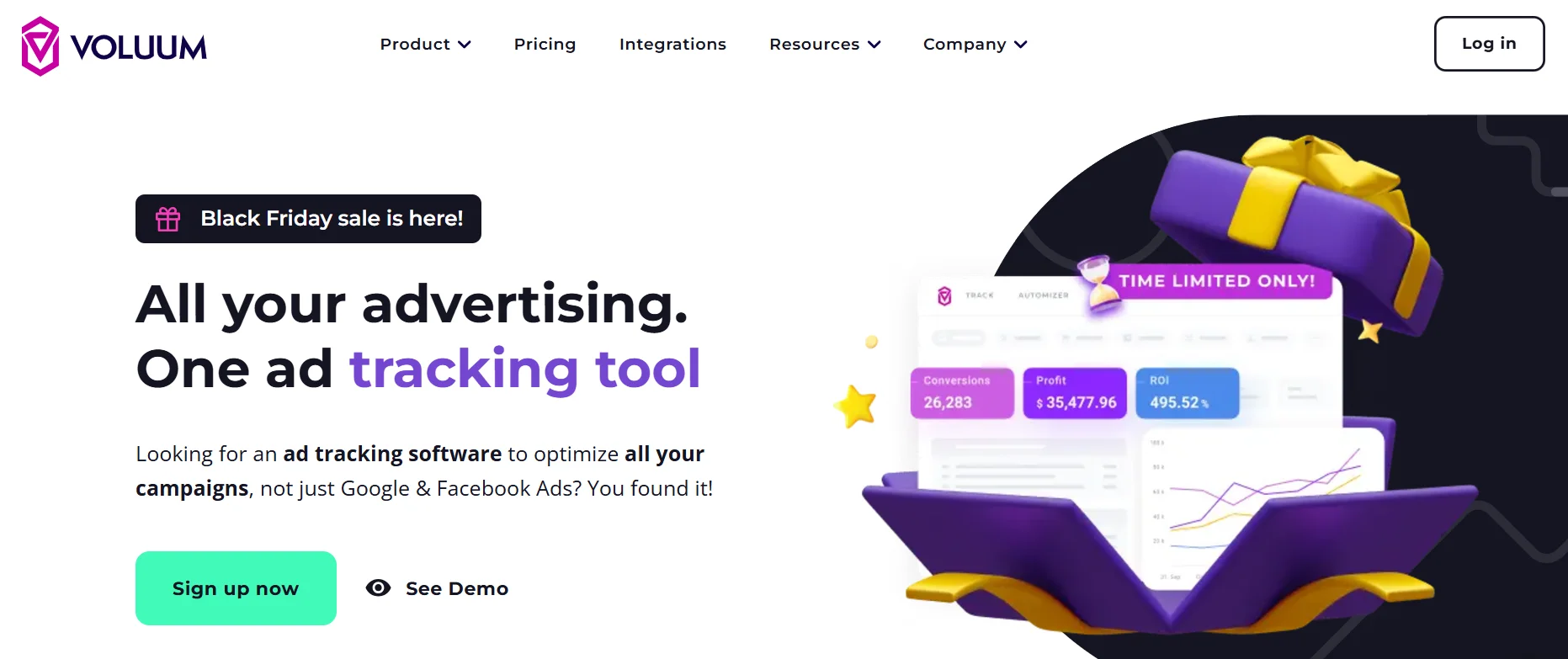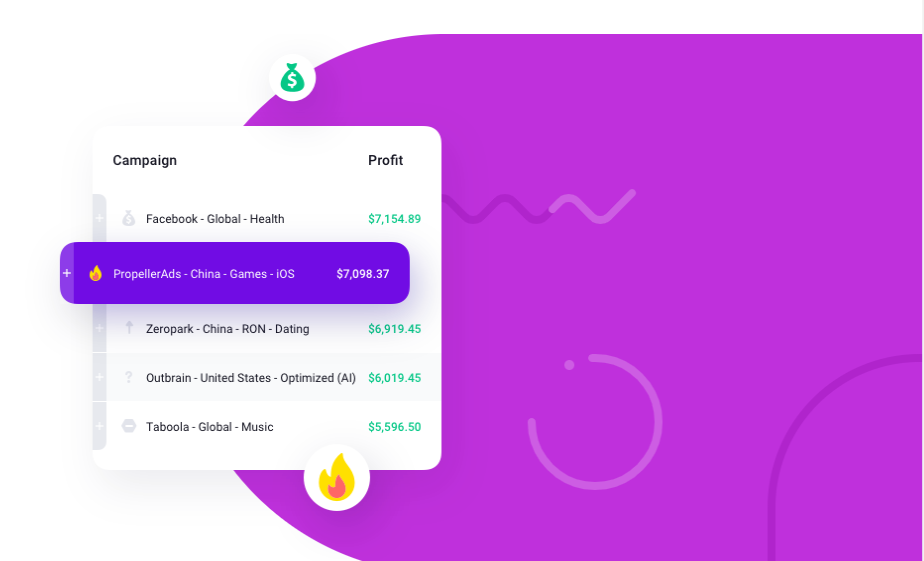
VoluumLearn More |

FunnelFluxLearn More |
|---|---|
| $ Pricing | $44 | $99 |
| Best for |
Voluum was launched in late 2013 or early 2014 in the beta phase. It has become the favorite of most major affiliates due to its innovation, ease-of-u |
With FunnelFlux, you can monitor the efficacy of any advertising effort, be it on Facebook, Google AdWords, Taboola, by email, or elsewhere. Make both |
| Features |
|
|
| Pros | |
|
|
| Cons | |
|
|
| Ease of Use | |
|
Voluum is a hosted tracking system, meaning you live in the cloud. Some customers are skeptical when other people should be able to host their campaign data. Its user interface is really easy to navigate. |
FunnelFlux is unquestionably an advancement. Processes like setting up the campaign, dividing test landing pages, and manually optimizing rules are made simpler. It can be operational within a few minutes. |
| Value For Money | |
|
Voluum appeared when most tracking systems stopped renewing their products. Voluum's top-level crawler and numerous new upgrades make you feel like you're tracking campaigns in the future. It's worth every penny. |
FunnelFlux tracks all ready-made campaigns. Direct links, landing pages, numerous routes, lead captures, landing page sequences, and email tracking function without code. So it's worth investing. |
In this post, I’ll be comparing FunnelFlux vs Voluum, two popular affiliate tracking tools, and giving you a detailed breakdown of each.
Are you looking for a new tracking platform but not sure which one to choose? I get it. With so many options out there, it’s easy to get overwhelmed. If you search for tracking platforms on Google, every tool seems to claim it’s the best.
In this article, we’ll examine how FunnelFlux Pro, our top pick, compares to Voluum, the industry leader.
If you’re starting in affiliate marketing, most tracking tools will get the job done. You’ll want a cloud-based solution to avoid dealing with server management, and most trackers offer similar features for things like tracking landing pages, offers, redirects, and reporting.
The real differences are in how easy the tool is to use and which specific features you need.
However, FunnelFlux Pro stands out from the rest. While many trackers have a similar layout and functionality—creating landers, offers, links, and campaigns—FunnelFlux offers some unique features and a different approach to managing campaigns.
FunnelFlux vs Voluum: Overview
Funnelflux Pro Overview
Using FunnelFlux, an effective reporting affiliate engine, you can track, sort, and find the traffic groups (like squeeze pages, CPA, and landing pages) that make you the most money with the least amount of work.
Here’s what I’m getting at.
Imagine that you don’t know which traffic routes are worth taking and which ones are a waste of time and money.
Or, if you’re trying to sell more of a product or service and are running more than one ad campaign, FunnelFlux can help you figure out which ads work best.
Voluum Overview
Voluum is the go-to tool for advertisers, affiliate marketers, and media buying teams when it comes to optimizing and measuring the efficacy of their online advertising campaigns.
The platform provides marketers with a suite of tools and services for monitoring, analyzing, and improving their efforts across various channels, including native, push, display, and mobile.
Funnelflux Pro As per My Experience
Features Comparison:
FunnelFlux vs Voluum: Data Passing
I really like this one because I know in the past, especially when I was new, I screwed up URLs often and made mistakes with tokens, copy/paste, and editing, and wasted countless hours trying to fix things.
Or worse, I ran campaigns for days with broken data that made it hard to optimize.
In most trackers, you fill out a URL and inject tokens into them. You get long URLs and they can be annoying to read, and it’s easy to make human error.
All it takes is putting ?something=x instead of &something=x and it all goes to hell.
In FunnelFlux Pro, you just put some base URL then build all this finicky data passing like this:
Another UX thing I like. You just put the fields/values here and use their dropdowns so you don’t make mistakes.
Offers are templated by the network configuration, too, so you never make rookie mistakes when adding new offer links and don’t have to add all this stuff every time.
Conditions
I like to figure out traffic optimization quickly and what landers, offers, etc., work best for different countries, devices, and so on.
In many trackers, this can be a little annoying, especially if you want to do anything other than lander > offer flows.
In FunnelFlux Pro, you can add condition nodes anywhere, create rules with their names, and visually see how things are routing. Like this:
I find this much easier than lists of landers/offers where I create rule after rule. Here I can visually map things out.
I can add these conditions anywhere, too… For example, I can add a geo-routing condition before landing pages, then another one on clickthrough to offers, and so on. Users move from node to node in the funnel, and you can control decisions at any point.
Not only is this freakin’ cool, but I think it lets you dream up ways to get out higher ROI that you didn’t think of in other trackers.
Quick stats
It’s just one of my favorite features because of the speed…
I go to the traffic sources page. I want to analyze a specific source. I click the quickstart button:
And boom, an overlay opens, breaking down the source by funnels. I can then jump to location data and in seconds get this breakdown:
For me, this is gold. I drill down via a fast overlay. When I close it, I am where I was before. I don’t have to jump between pages or open multiple tabs. It just feels more responsive, and the UI can keep up with my thought process.
Javascript and no-redirect tracking
One last thing…
A lot of marketers now are direct linking to pages and using javascript to do their tracking.
It’s a must on platforms like Facebook and Google where they don’t like redirects (not necessarily banned) and marketers are afraid of using redirect links if it could risk account bans, ad disapprovals, etc.
Most trackers offer Javascript tracking, and FunnelFlux Pro does too. But here is why I think it’s better:
- It’s kinda like Facebook JS, so it’s familiar. You place a global include then fire events like page view on your pages, and conversions elsewhere. The view includes a page ID and is the same for that lander no matter what funnel it is used in or the campaign involved.
- You can embed defaults like funnel and traffic source, so organic traffic defaults to something you choose
- Their javascript is super smart and automatically injects tracking data into links so that stuff doesn’t break even when cookies and referrers are blocked. This alone makes it more reliable than other trackers, especially if running on Facebook where their mobile browser blocks most third-party cookies.
- The javascript lets you use any tracker data — IDs, traffic source data, country, device model, etc. You don’t have to pass this in your URL! You can directly source it and use it in your page, JS functions, etc. I haven’t seen other trackers provide this.
- Because of the way it works, you can easily integrate with Google Tag Manager and use their lookup table feature to map out all your pages, and now you don’t need to place JS on pages at all, just GTM and add a page ID to the GTM setup. It can be tricky at first if you’re not used to GTM, but later it makes everything easy
- Lastly, and this is super cool, you can link directly between pages (like on a Shopify site or product site), without using tracker links, and the JS will intelligently create click events in their system if an action connects the pages! This is great as it lets you track CTR without having to change links on your website. For Ecom platforms this is critical as you often have no control over the links
FunnelFlux vs. Voluum: Cost Comparison
FunnelFlux vs Voluum: Pros and Cons
FunnelFlux Pros
- The FunnelFlux statistics module offers a great deal of flexibility.
- Without autoresponders, estimate your leads’ lifetime value.
- Fast affiliate tracking software. A $14.88 VPS gets 1M+ ticks every day.
- When it comes to assessing and improving a number of campaigns, it is incredibly accurate.
- It offers effective customer service support to assist you with any questions you might have.
- It contains a visual funnel heatmap graph that you can use to keep track of each campaign you’ve run.
- It automatically monitors more than sixty different Key Performance Indicators (KPIs).
- A visual funnel builder is included for quick and simple funnel development.
- It enables you to examine and understand the conversion rates of the landing pages of your rivals.
FunnelFlux Cons
- It will take a long time to learn and apply it.
- FunnelFlux cannot develop landing pages without third-party software.
Voluum Pros
- With Voluum, advertisers and promoters can anticipate live updates
- Tracking Domains with SSL
- It is very easy to use
- Voluum’s tracking, reporting, and A/B testing are popular. The software helps advertisers track traffic source revenue and campaign performance.
- Direct Tracking Pixel
- Outstanding Customer Service: Reviewers give Voluum’s account managers high marks because they reply quickly and offer personalized solutions. The staff helps many users with problems and questions about the platform.
Voluum Cons
- Complex Setup: The software’s many tabs and capabilities can be confusing for first-time users.
- Voluum’s Automizer, Fraud Analytics, and Extra Users charges made it pricey for some users.
Quick Links:
- Affiliate WP vs Cake Affiliate Tracking
- AffiliateWP vs ClickBank
- Trackier vs AffiliateWP
- Best Voluum Alternatives: Affiliate Ad Tracking Software
- Best Binom Alternatives to Try (#1 Pick)
FAQs
✅What are the benefits of Voluum?
Voluum provides every account owner with their own exclusive tracking domain, in addition to providing the option to utilize a user-specified domain for tracking reasons.
✅How does Voluum work?
Affiliate marketers, media buyers, and advertising agencies can all benefit from using Voluum, a cloud-based ad tracker. Advertising efforts may be easily monitored, improved, and automated. Users may immediately increase their advertising's effectiveness and return on investment (ROI) with the help of Voluum.
✅What is funnel flux?
Both an affiliate tracker and a visual builder, FunnelFlux combines the best of both worlds. Even if an affiliate has no prior experience with coding, they are able to construct their own landing pages with the assistance of this tool.
Conclusion: FunnelFlux vs Voluum 2024
In this battle, I think it comes down to whether you want the most mature, oldest tracker and can deal with its price-locking of features, or want the cheaper, more flexible FunnelFlux Pro and are OK with it not (yet) being as feature rich and being new to the market (as a SaaS offering at least).
FunnelFlux can fundamentally track more situations and complex funnels than Voluum and has a different approach to tracking. If you like the visual aspect and want to build funnels, like their UI, link generation approach etc. then go for them.
Our recommendation goes to FunnelFlux Pro since it is cheaper for most, has a newer and more flexible approach to tracking, has good support, is fast, and, importantly, doesn’t force you to upgrade (sometimes to almost $500/mo) just to have some of its features.











